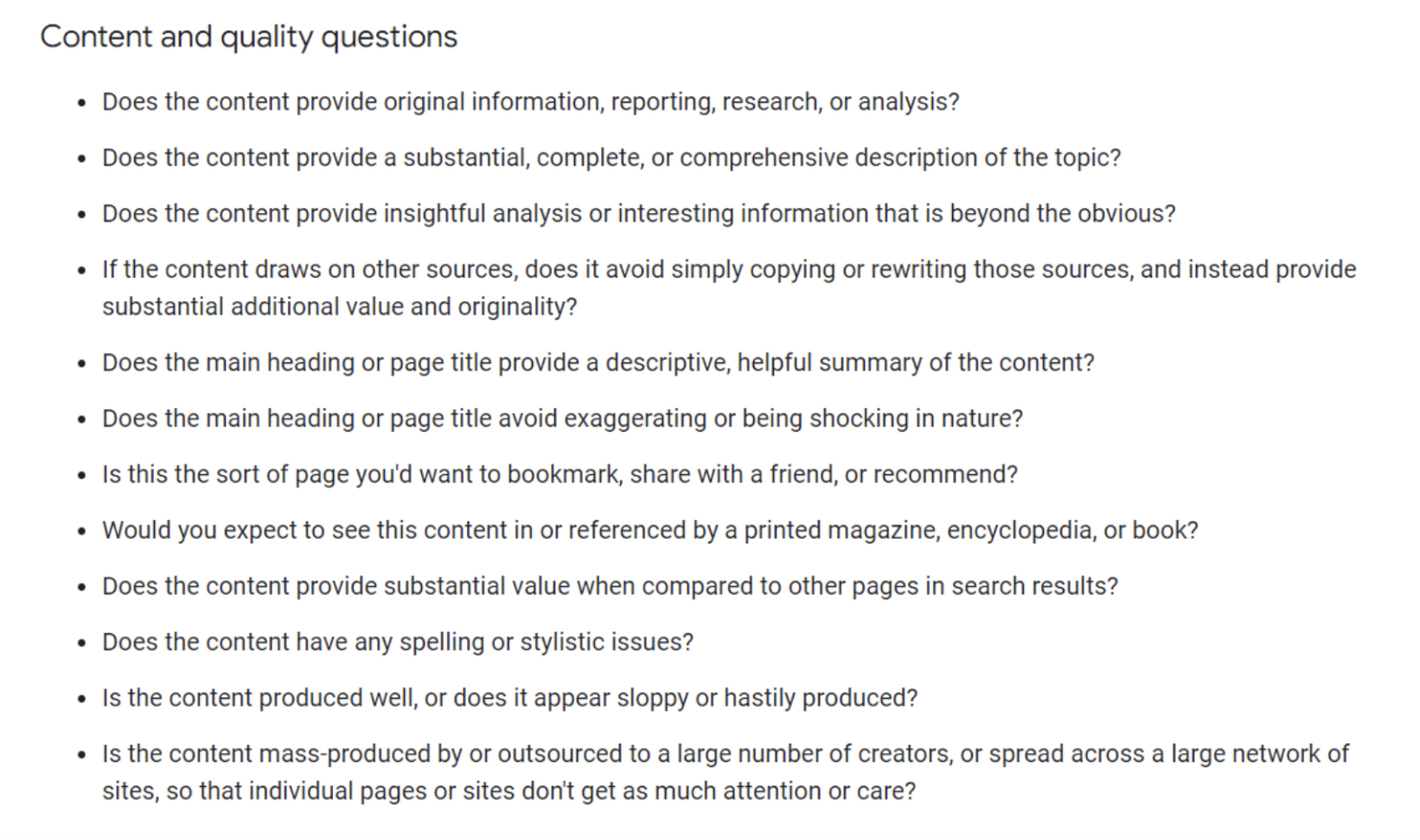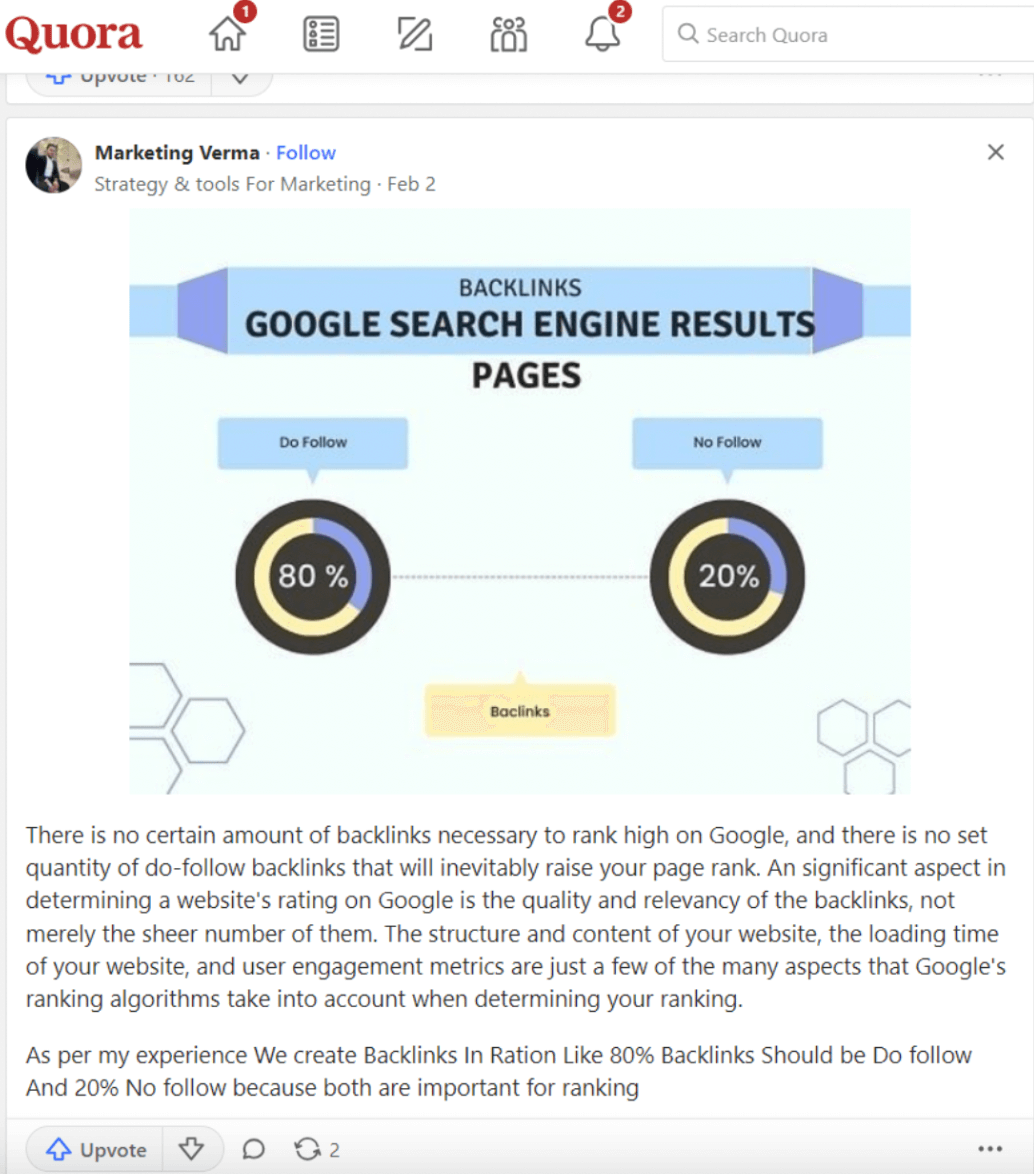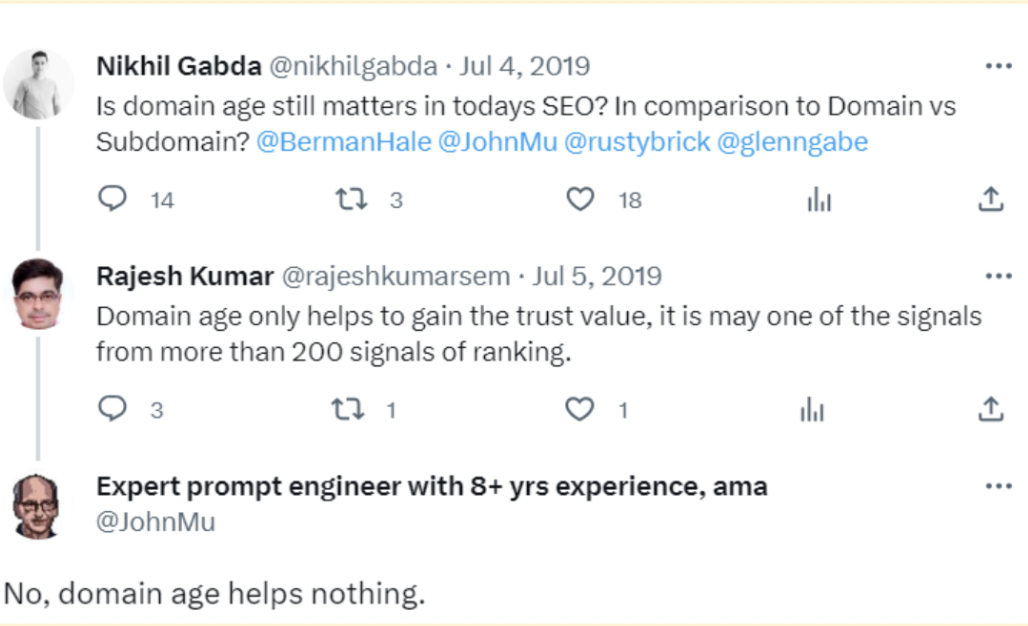What are the top Google ranking factors that impact rank positioning on SERPs?
Well, considering there are 200+ factors, it can be overwhelming to optimize accordingly. So, to avoid guesses and speculation, we have done the research for you. We’ve interviewed several SEO experts and analyzed several brands to uncover the truth about Google rank positioning determinants.
Let’s start with this fact.
Keywords Are Not the Be-All and End-All of SEO
Keywords are the foundation of SEO, but they’re not everything. In short, they help site owners understand what their audience is searching for and the content needed to answer their questions. They represent the main concepts of your research topic, including words used in everyday life to describe the topic. But, it’s important to note that there’s an exaggeration by most SEO experts on this singular factor as though it’s the only element that moves the needle.
There’s more to ranking on SERPs than just keywords.
Top Factors That Affect Your Ranking Position on SERPs
1. High-Quality Content
According to a recent report, roughly 7.5 million blog posts were published daily in 2023, with thousands targeting the exact keywords, especially short-tail keywords. Search engines, especially Google, want pages with the most helpful information at the forefront.
Nowadays, your content relevance is measured by how well it meets the E-E-A-T signal. Google stated that it uses the concept of E-E-A-T to evaluate if it’s search ranking systems provide helpful, relevant information. (Note: E-E-A-T isn’t a ranking factor. There is nothing like an E-E-A-T score, but the algorithm uses the idea of E-E-A-T to judge if content can be trusted, which automatically affects ranking.)
What type of content matches the E-E-A-T concept?
Google clearly stated, “ Google’s automated ranking systems are designed to present helpful, reliable information that’s primarily created to benefit people, not to gain search engine rankings, in the top search results.”
That’s what they tagged as creating helpful, reliable, people-first content.
Below are a few questions from Google Search Central to check if your page matches Google’s search helpful content system.

How Can You Vet Your Content Relevance?
1. Search Intent Satisfaction
Primarily, Google’s mission is to make information universally accessible and helpful. However, their core value is to provide relevant, high-quality results based on search queries. That’s why they prioritize people-first content.
Their recent Helpful Content System update clearly stated their priority on people-first content.
“Google Search’s helpful content system generates a signal used by our automated ranking systems to better ensure people see original, helpful content created for people in search results.
The helpful content system aims to better reward content where visitors feel they’ve had a satisfying experience, while content that doesn’t meet a visitor’s expectations won’t perform as well.
The system generates a site-wide signal that we consider among many other signals for use in Google Search (which includes Discover). The system automatically identifies content that seems to have little value, low-added value, or is otherwise not particularly helpful to people.”
Here are a few questions Google shared as a gauge to measure how your content matches search intent:
- Do you have an existing or intended audience for your business or site that would find the content useful if they came directly to you?
- Does your content clearly demonstrate first-hand expertise and a depth of knowledge (for example, expertise that comes from having actually used a product or service or visiting a place)?
- Does your site have a primary purpose or focus?
- After reading your content, will someone leave feeling they’ve learned enough about a topic to help achieve their goal?
- Will someone reading your content leave feeling like they’ve had a satisfying experience?
For further understanding, Google stressed this point in their SEO fundamentals documentation that considers evaluating your content in terms of “who,” “how,” and “why.” The “why” is the most essential factor:
“Why (was the content created)
“Why” is perhaps the most crucial question to answer about your content. Why is it being created in the first place?
The “why” should be that you’re creating content primarily to help people, content that is useful to visitors if they come to your site directly. If you’re doing this, you’re aligning with E-E-A-T generally and what our core ranking systems seek to reward.
If the “why” is that you’re primarily making content to attract search engine visits, that’s not aligned with what our systems seek to reward. If you use automation, including AI generation, to produce content for the primary purpose of manipulating search rankings, that’s a violation of our spam policies.”
The likelihood of your page ranking on the first page for your target keyword is determined by how much your content matches search intent.
Read our blog post on search intent to further understand how people search.
2. Proper Keyword Optimization
Even though search engines frown upon keyword stuffing, you can’t sideline keywords. That’s why search engines use the level at which a keyword is adequately optimized on a page to judge its relevance to the search query.
But is there a standard number of times to use a keyword on a page?
We recommend you work your keywords naturally into your content rather than boring your readers with consistent use of one word or phrase. You can also use synonyms of your keywords where possible to help you avoid keyword stuffing.
However, ensure you use your target keyword early in your page to benefit from a ranking signal known as keyword prominence.
In his recent weekly Question and Answer sessions, Google’s John Mueller explains how keyword prominence boosts user experience and the right place to use your keywords.
“I would recommend, if there’s something you want to tell us that your page is about, to make that as visible as possible. So don’t just put that as a one-word mention on the bottom.
Instead, use it in your titles, use it in your headings, use it in your subheadings, use it in your captions from images, all of these things to make it as straightforward as possible for users and Google when they go to your page that this page is about this topic.
So that’s kind of the direction I would take there. I would not worry whether Google can get to the word number 20,000. Because if you’re talking about the word 20,000 and saying this is the most important keyword for my page, then you’re already doing things wrong.
You need to ensure that the information that tells us what this page is about is as obvious as possible so that when users go there, they’re like, “Yes, I made it to the right page; I will read what this page has to tell me.”
2. Authority
Let’s start with this excerpt from Google’s update on creating helpful, reliable, people-first content documentation.
“Google’s automated systems are designed to use many different factors to rank great content. After identifying relevant content, our systems prioritize those that seem most helpful. To do this, they identify a mix of factors that can help determine which content demonstrates aspects of experience, expertise, authoritativeness, and trustworthiness, or what we call E-E-A-T. Of these aspects, trust is most important.”
How do you build trust to your page?
Quality backlinks!
When relevant and authoritative sites link to your page, it sends a signal to the search engine algorithm that there is information in your content more people need to know, which positively affects your ranking in search results.
However, recently, Google has shifted its gear in how the value of backlinks is evaluated. Google now prioritizes the quality of backlinks over the number of links. The goal is to ensure that the sites that rank on SERPs have real authority and to minimize spammy links.
But how many links does a page need to rank on SERP?
Someone asked this question on Quora a few months ago. Here is one of the responses that captured the answer in detail.
No standard number of links determines a site’s ranking on SERPs. However, several factors determine the right amount of links needed: the keyword difficulty of your target keyword, your competitors’ domain authority, and your site’s DA compared to your competitors.
That’s why we recommend prioritizing getting quality links in their numbers to give you leverage.
3. Page Experience
Imagine going to a fast food restaurant for a quick meal. Once you get there, their service is slow, and getting your food takes a long time. Again, the restaurant layout is so confusing that you had difficulty finding the counter to place your order.
You came in for a quick and convenient meal, but the experience made you regret not going home to prepare food.
Similarly, when visitors come to your website, they expect it to load quickly and easily find what they are looking for, thanks to a responsive, intuitive design.
If your site has a poor page experience, it’s like that frustrating restaurant experience. Visitors may decide it’s nothing more than an asshole and go elsewhere for what they need.
In their Understanding Page Experience documentation, Google emphasized that their core ranking system rewards sites that provide an excellent page experience.
But there isn’t a single page experience score; instead, the algorithm uses different signals aligning with the overall page experience.
Let’s examine the core page experience signals:
1. Google Core Web Vitals
Core Web Vitals are metrics that measure real-world user experience for loading performance, interactivity, and visual stability of the page. Each Core Web Vitals represents a distinct facet of the user experience, is measurable in the field, and reflects the real-world experience of a critical user-centric outcome.
The metrics that make up Google Core Web include:
- Largest Contentful Paint (LCP), which measures loading performance. To give your readers a good user experience, LCP should occur 2.5 seconds or less after the page starts loading. Anything above 4.0 seconds shows that the page needs improvement.
- First Input Delay (FID), which measures interactivity. Your page should have an FID of 100 milliseconds or less for a good user experience. Anything above 300 milliseconds is a signal that the page needs improvement.
- Cumulative Layout Shift (CLS), which measures visual stability. Your page should have a CLS of 0.1 or less for a good user experience. A page with a CLS of 0.25 provides a poor user experience.
Reducing Cumulative Layout Shift (CLS) by 0.2 led Yahoo! JAPAN to a 15% increase in page views per session, 13% longer session durations, and a 1.72 percentage point decrease in bounce rate.
Google recommends that for each metric, a suitable threshold to measure is the 75th percentile of page loads, segmented across mobile and desktop devices. Besides, research showed that when a site meets the Core Web Vitals thresholds, users were 24% less likely to abandon page load.
2. Clean Code
Let’s start with this simple question.
Clean code tends to have fewer bugs, so the site runs faster and more efficiently. This fosters quicker load times, leading to a more reliable user experience.
3. Mobile Friendliness
Google released this statement on April 21, 2015, to notify its users about its new update – a mobile-friendly update.
“As we noted earlier this year, today’s the day we begin rolling out our mobile-friendly update globally. We’re boosting the ranking of mobile-friendly pages on mobile search results.
Now searchers can more easily find high-quality and relevant results where text is readable without tapping or zooming, tap targets are spaced appropriately, and the page avoids unplayable content or horizontal scrolling.”
The goal was to ensure mobile phone users have a stellar experience.
However, on March 16, 2016, Google released an update that strengthened mobile-friendliness as a crucial ranking signal.
“Today, we’re announcing that beginning in May, we’ll start rolling out an update to mobile search results that increases the effect of the ranking signal to help our users find even more pages that are relevant and mobile-friendly.”
A poor mobile design can adversely impact your page’s search ranking. That’s not our opinion but a statement baked from Google’s Page Experience Core update.
Read the mobile site documentation to learn the best practices for a mobile-friendly site.
Ready to self-assess your content’s page experience?
Answering yes to the questions below means you’re probably on track to provide a good page experience:
- Do pages have good Core Web Vitals?
- Are pages served in a secure fashion?
- Does content display well for mobile devices when viewed on them?
- Does the content lack excessive ads that distract from or interfere with the main content?
- Do pages lack intrusive interstitials?
- How easily can visitors navigate to or locate the main content of your pages?
- Is the page designed so visitors can easily distinguish the main content from other content on your page?
4. Consistency
Nichole Popatco, SEO Specialist at M2.0 Communications, shared an insight explicitly explaining this point.
“SEO results, especially in the highly competitive landscape of Google, mean success doesn’t happen overnight. Paying attention to the smallest details takes patience and hard work. Take time to do the right things upfront instead of trying to hurry things up. This approach saved us time and allowed us to optimize our website within three months in the different aspects of SEO (keywords, technical SEO, on-page SEO, and off-page SEO).”
Acclaimed Google Search Ranking Factors That Do Not Impact SERPs
1. Bounce Rate
Bounce rate refers to the percentage of visitors who enter a website, take no action, and then leave (or “bounce”) without viewing any other pages on the same website. Logically, the bounce rate doesn’t necessarily indicate a bad user experience. People can click on a page, read it, have their questions answered quickly, and leave. It doesn’t make sense for Google to punish your site because your readers left early.
Several reports from Google’s top officials show that its algorithm doesn’t use bounce rate as a ranking factor:
Gary IIIyes, Webmaster Trends Analyst at Google, stated clearly in his May 13, 2015 tweet, “…we don’t use analytics/bounce rate in search ranking.”
Also, John Mueller, Webmaster Trends Analyst at Google, said at the Webmaster Central office hours on June 12, 2022,
“I think there’s a bit of misconception here that we’re looking at things like the analytics bounce rate when it comes to ranking websites, and that’s not the case.”
2. Content Length
Content length as a ranking factor is one of the most protracted debates in SEO.
Some SEO experts even recommend a standard word count as the magic wand to land on the first page of SERPs.
The truth is that word count doesn’t impact rank positioning. Google aims to push content that satisfies search intent. Whether that will take 100 words, 200 words, or 5000 words is of no concern to the algorithm.
In a Reddit thread, Google’s John Mueller shared, “Word count is not a ranking factor. Save yourself the trouble.”
He also mentioned in a Q&A session, “From our point of view, the number of words on a page is not a quality factor, not a ranking factor. So just blindly adding more and more text to a page doesn’t make it better.”
3. Domain Age
As age is not a substitute for value, likewise, search engine algorithms do not consider how long you’ve registered your domain as a ranking factor.
4. Domain Authority
In 2022, a Reddit user asked about Domain authority and its impact on a site.
Google’s John Mueller responded,
Domain authority is not a ranking factor. Rather, it’s a metric by an SEO company calculated using several factors, including the number of backlinks and more.
5. Keyword Density
In an official Google video in 2011, Matt Cutts confirmed that Google doesn’t have an ideal keyword density. He further explained that keyword overuse has more harm than good to a site.
“I would love it if people could stop obsessing about keyword density. It’s going to vary. It will vary by area and based on what other sites rank. It’s not a hard and fast rule, and anyone who tells you there is a hard and fast rule, you might be careful because they might be selling you keyword density software or something along those lines.”
6. Social Signals
Social signal is not a ranking factor but can indirectly affect your SERP ranking.
In 2021, John Mueller was asked if social media directly or indirectly affected search rankings.
He said, “If I give you advice on Twitter, which helps improve your website’s visibility in search, would that be an indirect effect of social signals on SEO?”
Final Words
It doesn’t take long to slip off the SERP track if you’re not fully on guard. That’s why constant rank tracking is required to remain relevant in the SEO world. Keyword.com is an SEO ranking checker that accurately tracks keyword positions without the chaos.
Just open a new tag, dump in your keywords, and it’s done! Interestingly, this tool helps you discover your actual SERP competitors with the strategies to outrank them. More so, this tool provides daily ranking updates that give you an edge over keyword fluctuations.
Try your 14-day free trial now to see your rank positioning on mobile and desktop devices with a 1-click shareable report that looks like the real SERPs.




